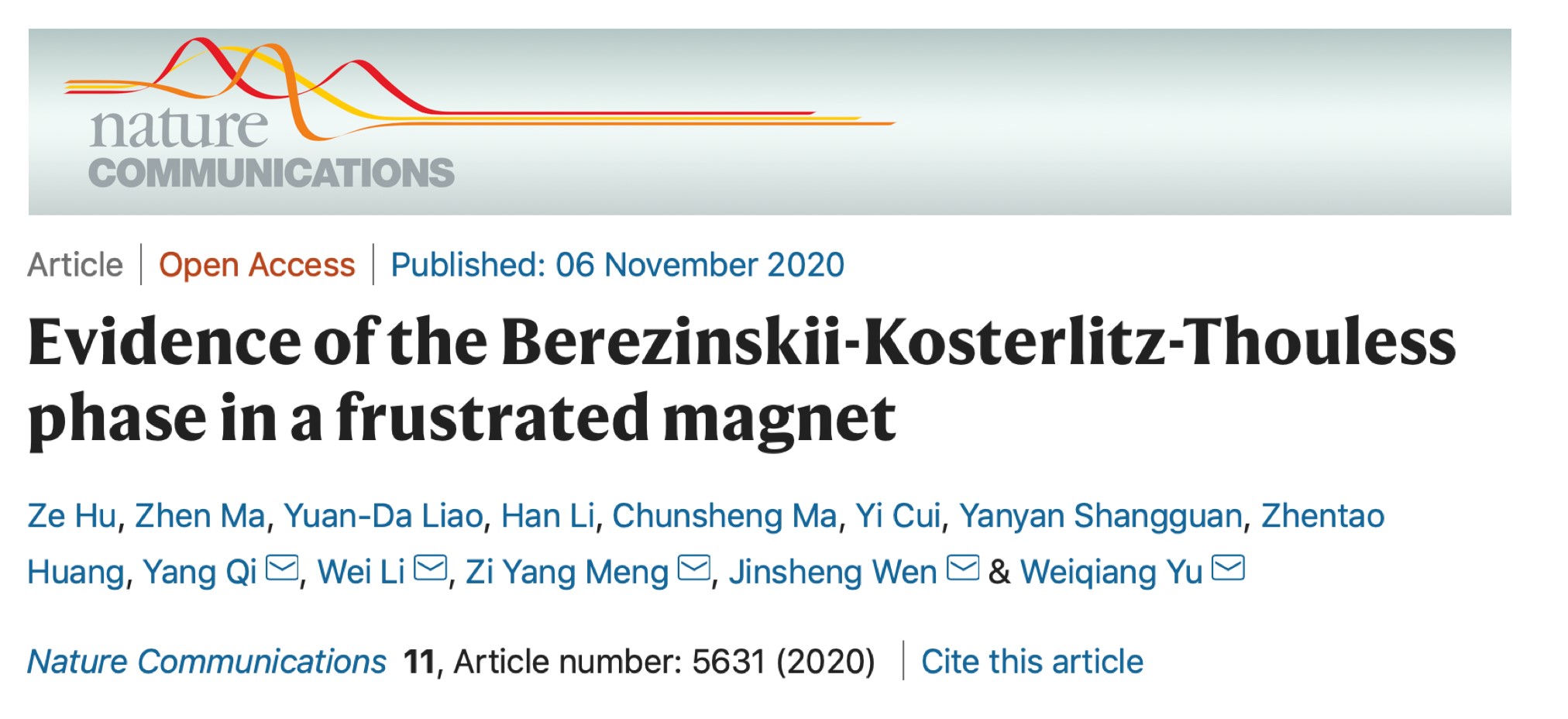Recently, a research group from the School of Physics of Beihang University and their collaborators published their latest findings titled “Evidence of the Berezinskii-Kosterlitz-Thouless Phase in a Frustrated Magnet” in Nature Communications, reporting the new progress in the study on Berezinskii-Kosterlitz-Thouless (BKT) physics in magnetic materials. Li Han, a Ph.D candidate from the School of Physics, is the co-first author. Associate Professor Li Wei is the co-corresponding author of the article.

By carrying out such experiments as nuclear magnetic resonance (NMR) and low-temperature thermodynamic measurement, the researchers detected the low-energy electronic states and a critical scaling behavior of the magnetic susceptibility expected for the BKT transition of the 2D frustrated magnet TmMgGaO4. The experimental findings are highly consistent with the theoretical simulation results, which substantiates the group's previous prediction.
The BKT mechanism, building upon proliferation of topological defects in 2D systems, is the first example of phase transition beyond the Landau-Ginzburg paradigm of symmetry breaking. Such a topological phase transition has long been sought yet undiscovered directly in magnetic materials. The research group from the School of Physics has been committed to the study of TmMgGaO4 since 2019, and they obtained the microscopic model and accurate parameters of TmMgGaO4 via the tensor renormalization group calculation and precise fitting of experimental results. Based on these parameters, the group calculated the thermodynamic and kinetic properties of the system, revealed the vortex-antivortex pair excitations, and predicted the BKT transition of the 2D frustrated magnet TmMgGaO4. Preliminary research results have been published in Nature Communications in February, 2020 (Nat. Commun. 11, 1111 (2020)).
Since the BKT phase transition is an infinite-order phase transition, new ideas are necessary for detecting this phase transition. After repeated discussions, the research group decided to employ NMR technology to accomplish this challenging task.
Benefiting from NMR as a sensitive low-energy probe, and the nearly zero planar gyromagnetic factor in a TLI magnet TmMgGaO4, the researchers revealed two BKT transitions and a critical BKT phase with an emergent XY symmetry. Together with the power-law behavior of the susceptibility and excellent agreement between their QMC simulation and experiment data, they unambiguously identified the long-sought BKT phase in a magnetic crystalline material.

Finite-temperature phase diagram and the corresponding spin configuration of the TmMgGaO4
The research group at the School of Physics has achieved some results in recent years. Combining quantum many-body simulation techniques and the first-principles calculation, they have gained a series of achievements in multibody computing and quantum magnets. They also work closely with domestic and foreign high-level research groups to jointly explore novel quantum states and multi-body effects in strongly correlated and strongly frustrated magnetic materials.
This work is the result of close cooperation between several theoretical and experimental research groups. Other collaborators include the research group of Wen Jinsheng from Nanjing University, the group of Yu Weiqiang from Renmin University of China, the group of Meng Ziyang from the University of Hong Kong, the group of Qi Yang from Fudan University, etc. The research was supported by the National Key Projects for Research and Development of China, the National Natural Science Foundation of China, etc.
More information of the article:
https://www.nature.com/articles/s41467-020-19380-x
Webpage of the research group at the School of Physics:
https://wlibuaa.github.io/
Reported by Liu Rui
Reviewed by Li Guangchao
Edited by Jia Aiping and Lyu Xingyun
Translated by Lyu Xingyun

